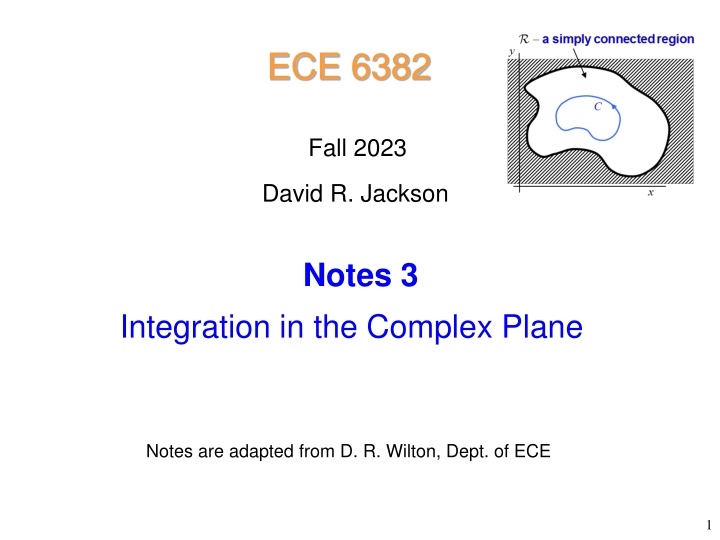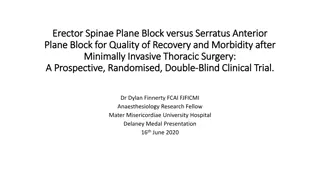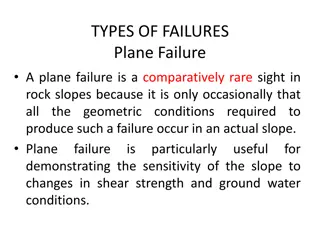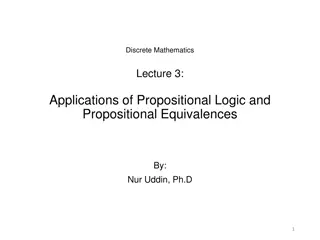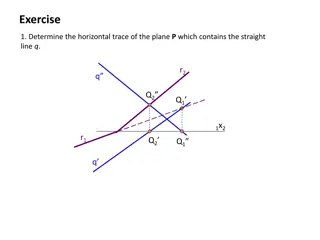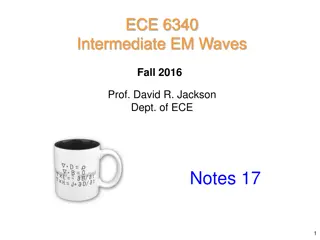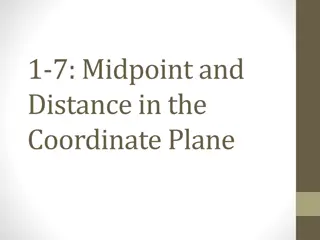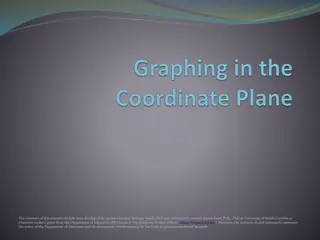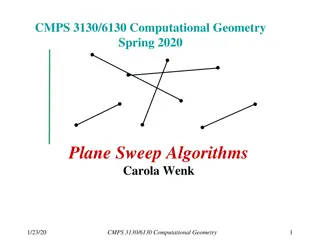Integration in the Complex Plane: Definitions and Equivalences
Learn about line integrals in the complex plane, equivalence between complex and real line integrals, and review of line integral evaluation. Understand how to evaluate line integrals using parameterization and examples.
Download Presentation

Please find below an Image/Link to download the presentation.
The content on the website is provided AS IS for your information and personal use only. It may not be sold, licensed, or shared on other websites without obtaining consent from the author.If you encounter any issues during the download, it is possible that the publisher has removed the file from their server.
You are allowed to download the files provided on this website for personal or commercial use, subject to the condition that they are used lawfully. All files are the property of their respective owners.
The content on the website is provided AS IS for your information and personal use only. It may not be sold, licensed, or shared on other websites without obtaining consent from the author.
E N D
Presentation Transcript
ECE 6382 Fall 2023 David R. Jackson Notes 3 Integration in the Complex Plane Notes are adapted from D. R. Wilton, Dept. of ECE 1
Defining Line Integrals in the Complex Plane Define on between and C z z 1 n n n y Consider the sums = b z z N n N N z ( )( ) C 1 = N I f z z 1 N n n n n nz = 1 n 3 3z 2z Let the number of subdivisions such that N and define 2 1z ( ) = 1 0 z z z 1 n n n = a z 0 b ( ) f z dz x = lim N I I N a z n N ( )( ) = lim N f z z 1 n n n b = 1 n ( ) f z dz ( ) f z dz = I (The result is independent of the details of the path subdivision, for reasonably well-behaved functions.) C a 2
Equivalence Between Complex and Real Line Integrals Denote b b ( ) f z dz ( ) ( ) ( ) = + + I u x,y iv x,y dx idy a a ( ) ( ) = = b x ,y b x ,y N N N N ( ) ( ) ( ) ( ) = + + u x,y dx v x,y dy i v x,y dx u x,y dy ( ) ( ) = = a x ,y a x ,y 0 0 0 0 = + + udx vdy i vdx udy C C = + + I udx vdy i vdx udy C C The complex line integral is equivalent to two real line integrals on C. 3
Review of Line Integral Evaluation y ( ) ( ) A line integral written as u x,y dx v x,y dy = t t C f N N t is really a shorthand for C 1 nt ( ) t ( ), ( ) x t y t f dx dt dy dt 3t u v dt 2t 1t t 0 t where is some parameterization of : C 0t x ( ) ( ) = = C : x x t , y y t , t t t 0 f t = t t nt N t 0t 2t 1t 3t f N 1 The path C goes counterclockwise around the circle. 2 2 2 + = Examp le : parameterizations of the circle x y a t = = = 1) ( ) cos sin 0 2 x a t, y a t, t 2 2 = n = = = 2 ) x a t, y d a t , t a, t a, t 0 f -a -a a a t 2 2 = = = = x t, y a t , t a, t a, 0 f 4
Review of Line Integral Evaluation (cont.) y = t t f N Nt C 1 nt ( ) ( ), ( ) x t y t 3t 2t 1t 0t x While it may be possible to parameterize using or as the independent parameter, it must be remembered that the other variable ( or ) is in general always a C x y of that parameter! function y x ( ) ( ) u x,y dx v x,y dy Ill ustration: C The red color denotes functional dependence. x f dy dx ( ) ( ) ( ) y x ( ) y x = (if is the independent parameter) u x, v x, dx x x 0 y f dx d ( ) ( ) ( ) x y ( ) y = (if is the independent parameter) u ,y v x ,y dy y y y 0 5
Line Integral Example 1 z y = Evaluate :where I dz Consider z C , y C = = a cos sin 0 C : x a a , x Although it is easier to use polar coordinates (see the next example), we use Cartesian coordinates to illustrate the previous Cartesian line integral form. + 1 z 1 + 1 + x iy iy x + y x y ( ) f z = = = = + = + i i 2 2 2 2 2 2 x iy x iy x x y x y a a = + + I udx vdy i vdx udy C C Hence ( + ) ( ) = u iv dx + + v iu dy + x C C ( ) = u z = I I 2 a 1 2 The red color denotes functional dependence. y ( ) v z = a 0 ( ) x x y a ( ) y a y x 2 a = + = + I i dx I i dy 1 2 2 2 2 2 a a a 0 6
Line Integral Example (cont.) y Consider a z ( ) x x y a C = + I i dx a 1 2 2 a a x a 1 x 2 2 = + i a x dx 2 2 a a a a 1 2 2 = + 0 i a x dx 2 a a a 2 2 2 1 x a x a x a 1 = + sin i 2 2 2 a a 2 1 a = i 2 2 2 2 a = i 2 7
Line Integral Example (cont.) 0 ( ) a y x y y = + I i dy 2 2 2 a 0 Consider z C 0 i = + a 0 ( ) y x dy 2 a 0 x 0 2 2 ) ( 0 a i i 2 2 2 2 = + a y dy a y dy 2 2 a a 0 a a i 2 2 = 2 a y dy 2 a 0 a 2 2 2 y a y i a y 1 = + 2 sin 2 2 2 a a 0 2 i a a a 1 = 2 sin 2 2 a = i 2 8
Line Integral Example (cont.) y = + = + I I I i i Consider 1 2 z 2 2 C a x Hence = i I y C z a Note: By symmetry (compare z and z, and compare dz), we also have: x 1 z = 2 dz i C 9
Line Integral Example y Consider n Evalu ate : where z dz z z C r C = = cos = = sin 0 2 C : x r , y r , x i + = cos sin z r ir re , i dz rie d , 2 ( ) n i i n = z dz re rie d 0 C 2 ( ) 1 + 2 i ( n e i ( ) + + i + 1 n 1 1 n n = = ( 1) ir e d i r n ) + 1 n 0 0 ( ) + This is a useful result, and it is used to prove the residue theorem . 1 n = 2 i 0 1 , n i, n 1 e + 1 n = = r ( ) + 2 1 1 n Note: For n = -1, we can use the result on slide 9 (or just evaluate the integral in directly). 10
Cauchys Theorem Cauchy s theorem: Consider ( ) f z ( ) f z dz = If is analytic in then R 0 C y A simply-connected region means that there are no holes in the region. (Any closed path can be shrunk down to zero size.) a simply-connected region R C x 11
Proof of Cauchys Theorem a simply connected region R y ( ) f z = = + First, note that (from slide 3) if then w u iv, ( ) f z dz = + + ; udx vdy i vdx udy C C C C then use Stokes's theorem (see below). x = = + = + Construct 2D vectors and write the integral above as in the plane A ux vy, B vx uy, dr dx x dy y xy Stokes's Theorem ( ) f z dz ( ) ( ) = A dr + B dr = + but zdS zdS , i A i B interior of interior of C C C C C x y x y z z cond's cond's C.R. C.R. v u u v ( ) ( ) = = = = = = z z z z 0 0 A , B x y z x y x y z x y 0 0 u v v u ( ) f z dz = 0 C 12
Proof of Cauchys Theorem (cont.) Some comments: ( ) ( ) continuous first derivatives and that be smooth . The proof using Stokes's theorem requires that have u x,y ,v x,y C is often called the The Goursat proof removes these restrictions; hence the theorem Cauchy -Goursat theorem . 13
Cauchys Theorem and Path Independence ( ) f z ( ) f z dz = 0 is analytic Consider C This implies that the line integral between any two points is as long as the function is analytic in the region enclosed by the paths. independent of the path , a simply-connected region R a simply-connected region R y y C 2 C C 1 x x ( ) f z dz ( ) f z dz = ( ) f z dz ( ) f z dz ( ) f z dz = = 0 C C C C C 1 2 1 2 14
Extension of Cauchys Theorem to Multiply-Connected Regions y y simply-connected region a multiply-connected region R R 2c 1c C C C C 2 2 1 1 x x ( ) f z ( ) f z dz If is analytic in then in general. R 0 C 12 , Introduce an infinitesimal- width "bridge" to make into a simply connected region ( ) ( ) C C R R ( ) f z = = since integrals along are in 0 dz f z dz f z dz c , c 1 2 + + C C c 2 c 1 2 1 2 1 ( ) f z dz ( ) f z dz = opposite directions and thus cancel C C 1 2 Note: The closed path integrals on C1 and C2 are not usually zero! 15
Extension of Cauchys Theorem to Multiply-Connected Regions Summary: Result for a multiply-connected region y a multiply-connected region R Note: The path cannot be shrunk down farther than the boundary of the island . C C 2 1 x ( ) f z dz ( ) f z dz = C C 1 2 16
Extension of Cauchys Theorem to Multiply-Connected Regions (cont.) Example: 1 z = 2 dz i The integral around the arbitrary closed path C must give the same result as the integral around the circle (and we already know the answer for the circle). C y C x 17
Cauchys Theorem, Revisited Consider If a function is analytic everywhere in a simply connected region, we can shrink down the path to zero size, which verifies that the line integral around a closed path in the region must be zero (since the integrand must be continuous and hence finite in the region). a simply-connected region R a simply-connected region R y y C C x x Shrink the path down. 18
Fundamental Theorem of the Calculus of Complex Variables y Consider bz z N z C 1 N This is an extension of the same theorem in calculus (for real functions) to complex functions. nz 3z 3z 2z 2z 1z 1z az x Assume that f is analytic in a region containing the path C. dF dz ( ) F z ( ) ( ) f z = = Suppose we can find such that : F z z b ( ) ( ) ( ) f z dz = F z F z b a z a 19
Fundamental Theorem of the Calculus of Complex Variables (cont.) y Proof Consider bz z N C Recall: z 1 N n The integal is path independent if is analytic on paths from nz 3z 3z ( ) f z 2z t o . z z 2z a b 1z 1z az Choose a particular path C. x On this path: z N b ( ) ( ) f z dz = lim N f z , z z z , 1 n n n n n = 1 n z a on between and (definition of line integral). C z z 1 n n n 20
Fundamental Theorem of the Calculus of Complex Variables (cont.) y Proof (cont.) Consider bz z N C z dF dz 1 N ( ) ( ) f z n = = Assume ; F z nz ( ) n F z ( ) 3z F z z F z 2z ( ) ( ) 2z 1 n = = n Hence f F n n 1z 1z n n az Note: The error in this approximation is proportional to | z| (see next slide). x z N N N b F z ( ) ( ) ( ) f z dz n = = = lim n z lim n z lim n z f z F z z n n n n n 0 0 0 = = = 1 1 1 n n n n z a ( ) ( ) ( ) ( ) ( ) ( ) + + = + lim n z F z F z F z F z F z F z 1 2 1 3 2 a 0 ( ) ( ) ( ) b F z ( ) + + + ( ) f z F z F z F z 1 ) 2 1 N N N ( ) b F z ( = (path independent if is analytic on paths from to ) F z z z a a b 21
Fundamental Theorem of the Calculus of Complex Variables (cont.) y Examination of Error in Approximation: Consider ( ) ( ) bz F z F z z z ( ) 1 n n N F n C z 1 N n n nz 3z 2z Use Taylor series: 2z 1z 1z 1 2 ( ) ( ) ( )( ) ( )( ) 2 = + + + F z F F z F z n n n n n n n n az 1 2 x ( ) ( ) ( )( ) ( )( ) 2 = + + + F z F F z F z 1 1 1 n n n n n n n n 1 2 ( ) ( ) ( ) ( )( ) ( )( ) 2 = + + + F z F z F F z F z 1 n n n n n n n n n 1 2 ( ) ( )( ) ( )( ) 2 + + + F F z F z 1 1 n n n n n n n ( ) ( ) ( )( ) F z F z z F z z z 1 z 1 2 1 2 ( )( ) ( )( ) 2 2 1 1 n n n n n = + + F z F z 1 n n n n n n n n n ( ) ( ) F z F z z 1 z 1 2 1 2 ( ) ( )( ) ( )( ) 2 2 1 n n = + + F F z F z 1 n n n n n n n n n )2 ( z n 22
Fundamental Theorem of the Calculus of Complex Variables (cont.) Fundamental Theorem of Calculus: z b ( ) F z ( ) ( ) f z dz = F z b a z a This permits us to make use of indefinite integrals : + 1 n az z n e n az = = = etc. sin cos z dz , z dz z, e dz , + 1 a Example: y 1 i + + 1 i + ( ) z dz ( ) z ( ) ( ) 1 i = = + sin cos cos 1 cos 1 i 1 C 1 x ( ) ( ) = + 0.540302 0.833730 0.988898 i 1 ( ) 0.293428 = + 0.988898 i (This result is path independent since sin is analytic everywhere!) 23
Fundamental Theorem of the Calculus of Complex Variables (cont.) Consider this integral: z z ( ) F z ( ) ( ) f z dz ( ) ( ) ( ) f z dz = = + F z F z F z 0 0 z z 0 0 Consider two different indefinite integrals: z ( ) ( ) ( ) = + for arbitrary F z f d F z z 1 1 1 1 z 1 z ( ) ( ) ( ) = + for arbitrary F z f d F z z 2 2 2 2 z 2 z 1 ( ) ( ) ( ) ( ) ( ) 1 = + = constant F z F z f d F z F z 2 1 2 2 1 z 2 This integral is some constant. All indefinite integrals can only differ by a (complex) constant. 24
Cauchy Integral Formula y y a simply-connected region R R 0z C C 0 0z x x 1 ( ) f z is assumed analytic in but we multiply by a factor (which is R ( ) z z 0 analytic except at and consider the following integral around ) : z C 0 ( ) z f z z = I dz ( ) 0 C To evaluate this, shrink that path to a small cir ( ) f z dz z z cular path path as show n : C 0 ( ) f z z = dz z 0 0 C C 0 25
Cauchy Integral Formula (cont.) z 0z We have: z ( ) f z z ( ) f z z C 0 = dz dz C z z 0 0 C C 0 i i = = Evaluate the integral on a small circular path, : C z z re , dz rie d 0 0 ( ) f z z 2 i e d ie i = 0 r r ( ) ( ) = i f z for 2 0 dz f z r ( ) 0 0 z r 0 0 C 0 ( ) f z z ( ) f z z Cauchy Integral Formula 1 ( ) ( ) = i f z = 2 dz f z dz 0 0 2 z i z 0 0 C C Note the The value of remarkable result: at is completely determined by its values on ( ) f z ! z C 0 26
Cauchy Integral Formula (cont.) Summary of Cauchy Integral Formula: z ( ) f z z 1 ( ) f z = dz 0 2 i z 0z 0 C C Another way to write it: ( ) f z z 1 ( ) f z = dz 2 i z C The Cauchy integral formula is useful for many purposes in complex variable theory. 27
Cauchy Integral Formula (cont.) Note that if is outside , the integrand is analytic inside ; hence by the Cauchy's theorem, we have z C C 0 ( ) f z z 1 = 0 dz 2 i z 0 C z0 is inside C z0 is outside C 0z 0z C C ( ) f z z ( ) f z z 1 1 ( ) f z = = 0 dz dz 0 2 i z 2 i z 0 0 C C 28
Cauchy Integral Formula (cont.) Cauchy Integral Formula: Summary of Both Cases: C 0z ( ) , z ( ) f z z i f z inside 2 , z outside C 0 0 = dz z 0 C 0 0 C Application: This gives us a numerical way to determine if a point is inside of a region: just set f(z) = 1. 29
Derivative Formulas Since f is analytic inside C, we can start with the Cauchy integral formula: 0z ( ) f z z 1 Analytic ( ) f z = (Note is inside ) dz z C . C 0 0 2 i z 0 C ( ) f z z 1 ( ) + = f z z dz 0 2 i z z 0 C ( ) z ( ) ( ) f z z ( ) f z z + f z z f z 1 i z 0 0 = dz 2 z z z 0 0 C 1 i z z z ( ) f z = dz ( )( ) z z z z 2 0 0 C ( ) z ( ) + f z z f z 1 1 ( )( 0 0 = lim z lim z f z dz )( ) 2 i z z z z z 0 0 0 0 C ( ) f z z 1 ( ) = Note: We have proved that you can differentiate w.r.t. z0 under the integral sign! f z dz 0 ( ) 2 2 i z C 0 30
Derivative Formulas (cont.) Similarly (derivation omitted): ( ) f z z 2 ( ) = f z dz 0 ( ) 3 2 i z C 0 0z In general: n 1 1 d dz ( )( ) C ( ) f z n = f z dz 0 n 2 i z z 0 0 C ( ) f z connected region containing analytic in a simply C ( ) f z z ! n ( )( ) n = f z dz 0 + ( ) 1 n 2 i z C 0 If f is analytic in a region, then all of the derivatives exist, and hence all of the derivatives are analytic as well. Note: All derivatives can be determined from f on the boundary! 31
Moreras Theorem ( ) f z f a function region and is continuous in a simply-connected R R z ( ) f z dz = 0 C closed contour R ( ) f z for throughout . within , then R is analytic every C ( ) f z region If is analytic in a simply-connected Cauchy's Theorem: then ( ) f z dz = , in . 0 C C ( ) f z = Morera's Theorem: is continuous in a simply- f a function ( ) f z dz connected region and for every closed contour 0 C ( ) f z within , then is analytic throughout . C These theorems are converses of one another! 32
Proof of Moreras Theorem ( ) f z Assume that the function region and is continuous in a R R ( ) f z dz = 0 z C for closed contour every within . R C 0 z Note:f will be analytic if we can prove its derivative exists! z z ( ) f z dz ( ) ( ) ( ) = d . is path independent, so define 0 f d F z f C z z 0 0 Note that ( ) ( ) z z F z F z z 1 ( ) ( ) ( ) ( ) 0 = = F z F z f d f d 0 z z z 0 0 z z 0 0 We can chose a small straight-line path between the two points since the integral is path independent. Along this small path, is almost constant (from contin ( ) ( ) ( ) 0 0 z z z z z ( ) ( ) 0 0 F z f z . F F z . F derivatives. Thus is analyticat But Note: uity of ). f f ( ) ( ) z z z z F z F z f z z f z z 1 0 ( ) ( ) 0 0 z 0 z = = = f d d z z f z 0 0 0 0 z 0 0 = Hence is analytic at any in (its derivative exists). But then so are all its R z 0 = Hence, is analytic at . f . f z 0 0 33
Properties of Analytic Functions ( ) z Existence of f Definition Cauchy-Riemann conditions ( ) f z dz = 0 C Analyticity Path Existence of derivatives of all orders independence 34
Cauchys Inequality y ( ) f z Suppose : ( ) f z (a) is bounded ( ) the circle of radius on M R C R (b) has a convergent power s eries repr sentation: e x = ( ) f z n (see note below) a z n = n 0 d n M R inside a ( ) the circl n o e of r adi us . R a . Then n n Consider this integral: ( ) m + f z z 1 1 1 n m 1 (This is from the previous line integral example, where n-m-1 = -1.) = = 2 dz a z dz ia n m 1 2 2 2 = 0 n z R = z R = ( ) m + ( ) m + 2 f z f z z 1 1 1 M M R = = a dz dz R d m 1 m + 1 2 2 2 1 m z R z R = z R = 0 m n M R ( ) f z max z R = a , M n n Note: If a function is analytic within and on the circle, then it must have a convergent power (Taylor) series expansion within and on the circle (proven later). 35
Liouvilles Theorem If f(z) is analytic and bounded in the entire complex plane, it is a constant. Because it is analytic in the entire complex plane, f(z) will have a power (Taylor) series that converges everywhere (proven later). Proof = ( ) f z By the Cauchy Inequality, n a z n = 0 M R n for any (so let ) a , R R n n = 0 = 0 a , n a n ( ) f z 0 ( ) f z No "interesting" (i.e., non-constant) function is analytic and bounded everywhere! n is analytic everywhere but unbounded at infinity z z are analytic everywhere but unbounded at infinity sin z, e 1 = is bounded at infinity but is not analytic at z z 0 ( ) 2 z z 0 36
The Fundamental Theorem of Algebra (This theorem is due to Gauss*.) N ( ) z n = The th degree polynomial, has (complex) roots. 0 0 N P a z , a , N , N N n N = 0 n Carl Friedrich Gauss As a corollary, an Nth degree polynomial can be written in factored form as ) ( ) ( ) z ( )( = P a z z z z z z 1 2 N N N * The theorem was first proven in Gauss s doctoral dissertation in 1799 using an algebraic method. The present proof, based on Liouville s theorem, was given by him later, in 1816. File:Carl Friedrich Gau signature.svg (his signature) http://en.wikipedia.org/wiki/Carl_Friedrich_Gauss 37
The Fundamental Theorem of Algebra (cont.) (by contradiction) Proof 1 First assume the polynomial has roots. Then no is analytic everywhere and ( ) z P N 1 1 = bounded at since lim z lim z 0 . ( ) z N P a z N N 1 ( ) z But by Liouville's theorem, we then have that is a constant, contrary to our P N assumption 0 N . ( ) z = Hence must have at least one root, say at . We can then write P z z 1 N ( ) ( z ) = (see note below). ( ) z P z z P 1 1 N N ( Repeat the above procedure ( ) ( ( ) 0 P z = where times (a total of ) 0 N z P times) until we arrive at the conclusion that 1 N N )( ) = P z z z z z z 1 2 N is a constant P . 0 Note: To verify this, we can use the method of polynomial division to construct the polynomial PN-1(z) in terms of an. An example is given on the next slide. 38
The Fundamental Theorem of Algebra (cont.) Example (polynomial division) ( ) ( z 3 2 = + + + = Assume a third-order polynomial has a root at . P z z a z a z a z z 2 1 0 1 )( ) ( ) 2 = + + Show that P z z z b z b . 1 1 0 0 Equate coefficients other than : z 2 = = + : z a b z b a z 2 1 1 1 2 1 1 = = + : z a b 1 1 b z b a 1 1 b z 1 0 0 1 )( ) ( ) ( 2 + + The difference between and must then be a constant. P z z z z b z b 1 1 0 = Since both terms vanish at ,this constant must be zero . z z 1 39
Numerical Integration in the Complex Plane Here we give some tips about numerically integrating in the complex plane. b ( ) f z dz I a One way is to parameterize the integral using z = z(t): We assume a given function and a given path. t = = y t t t t b dz dt ( ) ( ) 0 a = I f z t dt b b f = t t t a f N Nt C 1 so t nt ( ) b ( ), ( ) x t y t ( ) = 3t I F t dt 2t a 1t t a 0t x where ( ) z t dz dt ( ) = z ( ) ( ) ( ) t ( ) = + F t f z t F iF t R I t t b b ( ) t dt ( ) = + I F i F t dt R I t t a a 40
Numerical Integration in the Complex Plane (cont.) Summary t t t b b b b ( ) f z dz ( ) ( ) t dt ( ) = = = + I F t dt F i F t dt R I a t t t a a a Note: where It is not always necessary to treat the real and imaginary parts of F separately; we can just allow F to be complex in most software. dz dt ( ) ( ) ( ) ( ) t ( ) = + F t f z t F iF t R I The integrals in t can be preformed in the usual way, using any convenient scheme for integrating functions of a real variable (Simpson s rule, Gaussian Quadrature, Romberg method, etc.). Note: The variable t can be x, or , or any other convenient variable. 41
Numerical Integration of Analytic Functions Numerically Integrating Functions in a Region where they are Analytic If the function f is analytic, then the integral is path independent. We can choose a straight-line path! y t = 1 C We explore how this works. b a Note: If the path is piecewise linear, we simply add up the results from each linear part of the path. dz t = 0 x = + b a t, ( ) 0 1 z dz dt a t b a = ( ) ( ) ( ) = b a dt b a dt = b a = , arg arg dz dz dz 1 1 b dz dt ( ) ( ) ( ) f z dz ( ) ( ) ( ) = = I f z t dt b a f z t dt 0 0 a 42
Numerical Integration of Analytic Functions (cont.) Summary: 1 ( ) ( ) ( ) b a = I f z t dt = + b a t, ( ) 0 1 z a t y 0 We can use any method that we wish to evaluate this integral along the real axis. t = 1 b C a t = 0 x We can also break up the integral into real and imaginary parts if we wish*: 1 1 ( ) ( ) ( ) ( ) ( ) ( ) * This is usually not necessary for numerical integrations, since most software can handle complex functions. = b a + Re Im I f z t dt i b a f z t dt 0 0 Note: The term b-a is complex! 43
Numerical Integration of Analytic Functions (cont.) Example: = + b a t, ( ) 0 1 z a t b ( ) z dz = = 2 2 = + a i, b i sin I a y 1 ( ) ( ) ( ) b a = I f z t dt 0 2 2 = + b i C = a i 1 x ( ) ( ) = + + 2 sin (2+ ) I i i i t dt 0 This integral can be evaluated using any numerical integration package. 44
Numerical Integration of Analytic Functions (cont.) Uniform Partitioning = + ( ) 0 1 z a b a t, t 1 ( ) ( ) ( ) b a = I f z t dt y 0 t = 1 C b Note: If we partition uniformly in t, then we are really partitioning uniformly along the line with z. z a t = 0 x = b a = b a ( ) ( )/ z t N (We don t have to partition uniformly, but we can if we wish.) N segments = 1/ t N t t 1t nt 1 2t 0 45
Numerical Integration of Analytic Functions (cont.) 1 ( ) ( ) ( ) b a I f z t dt 0 = 1 t / N mid nt t t = 1 Uniform sampling (Midpoint rule): Nt nt 1t 2t 0 N ( ) ( ) mid n b a I f z t = + b a t ( ) z a = 1 n 1 2 mid n mid n mid n = + b a t = y ( ) z a , t t n N intervals Nz = b z C = b a = ( ) ( ) z t t z / b a Using N mid nz 0z z we then have = a z 0 N ( ) z x ( ) mid n b a I f z b a = 1 n 46
Numerical Integration of Analytic Functions (cont.) N ( ) mid n I z f z = 1 n where mid n mid n = + ( ) z a b a t y 1 2 = + ( ) a b a t n N intervals Nz = b z C N 1 N 1 2 mid nz = + ( ) a b a n 0z z = a z 1 2 0 = + a z n x 47
Numerical Integration of Analytic Functions (cont.) Complex Midpoint rule N ( ) mid n 2 I z f z Error z = 1 n b a N y = z N intervals Nz = b z C N 1 2 mid nz mid nz = + a z n 0z z = a z 0 x This is the same formula that we usually use for integrating a function along the real axis using the midpoint rule! (We essentially have a just rotation of the axis.) 48
Numerical Integration of Analytic Functions (cont.) Complex Simpson s rule z ( ) ( ) f z ( ) f z ( ) ( ) ( ) f z ( ) f z ( ) f z 4 + + + + + + 4 2 4 2 4 I f z f z Error z 0 1 2 3 4 1 N N 3 N= number of segments = even number y N intervals Nz = b z Number of sample points =N+1 N C nz 0z z ( ) = + = 01 , , nz a z n, n N = a z 0 x b a N = z 49
Numerical Integration of Analytic Functions (cont.) 6-point Gaussian Quadrature 1 6 ( ) ( ) F x dx F x w i i = 1 i 1 + B A A B = ( ) ( ) + Use x x 1,1 , x x A B 2 2 B A = dx dx 2 1 B 6 6 B A B A B A ( ) ( ) f x w ( ) f x dx ( ) i = = F x dx F x w i i i 2 2 2 = = 1 1 i i 1 A ( ) f x ( ) = F x Sample points Weights x1 = -0.9324695 x2 = -0.6612094 x3 = -0.2386192 x4 = 0.2386192 x5 = 0.6612094 x6 = 0.9324695 w1 = 0.1713245 w2 = 0.3607616 w3 = 0.4679139 w4 = 0.4679139 w5 = 0.3607616 w6 = 0.1713245 + B A A B i = + x x i 2 2 50
